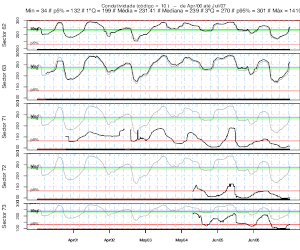MORWAQ

Project ID Card
- Principal Investigator: Luis Torgo
- Hosting Institution: LIAAD, INESC, Portugal
- Funding Agency: FCT (Portuguese Science Foundation)
- Project Duration: 2008 – 2011
- Budget: 47 kEur

Project Summary
This project has as main goal to develop models that can be used for monitoring and predicting water quality parameter values in the context of a water distribution network. Namely, the project will address this general goal in the context of the distribution network managed by the company Águas do Douro e Paiva (AdDP), SA, which is one of the institutions participating on this project, and is responsible for the water supply of the metropolitan area of Porto, the second largest city in the country. Monitoring and predicting water quality parameters is of key importance both to the company, which has legal limits to obey, but also to the public health, given the role of potable water on human life. In this context, AdDP carries out regular sampling procedures in different points of the distribution network with the goal of monitoring a set of parameters related with water quality. The project will use the data resulting from these sampling procedures carried out through several years. The models we will develop using these data will address two main problems.
The first problem is related to the monitoring activity over the large set of water quality parameters controlled by AdDP, with the goal of providing early warnings on eventual deviations according to the expected “normal” values. In the context of this task, we will develop models that are able to discover these “normal” values for each parameter. The motivation for these models lies on the fact that AdDP has observed that the notion of normality of each parameter is dynamic (provided the legal limits are obeyed), varying across time and place in the network, with factors like the (seasonal and other) patterns of the demand. On this monitoring task we will use models from the areas of activity monitoring and deviation detection, which will be adapted to the particular application of AdDP. This adaptation will involve the use of dynamic limits of normality as well as spatial information related to the topology of the distribution network, leading to what we would call spatio-temporal activity monitoring models. The second main problem being addressed in the project is the prediction of extreme values on water quality parameters across the network, with the goal of allowing early preventive actions can be taken to avoid the subsequent problems. The predictive models to be developed will use the available historical data, exploring both eventual temporal patterns on the data as well as spatial patterns that may be found by the models. With this type of spatio-temporal models we plan to take advantage of the probable influences caused by the natural flux of the water throughout the network. For this task we will adapt models for the prediction of rare extreme values that we have develop before in the context of a research project funded by FCT, to data with spatio-temporal features as it is the case of the data set to be provided by AdDP. In the context of predictive models, we will also develop techniques for forecasting values of water quality parameters in intermediate points of the distribution network using information on the values in other spatially related points. These models will have as main goal to allow reducing the operational costs of sampling activities within AdDP while maintaining the same level of water quality standards. In this context, we will also carry out a more exploratory analysis of the available data with the goal of discovering eventually existing correlations among the different water quality parameters whose existence and/or form may be unknown to AdDP. With this goal we will adapt a work on association rules previously carried out by elements of the consortium to the spatio-temporal setup of this project.

Project Goals
The main objective of the project is to contribute to the development of tools that can be used to maintain the quality of the water in the distribution network of the metropolitan area of Porto. This is a key objective for the AdDP company and achieving it has a large socio-economical impact in this area of Portugal given the size of the population served by this distribution network. The project will help this general goal by means of:
-
developing models for monitoring water quality parameters measured across the network, with the goal of timely signaling abnormal deviations.
-
developing predictive models for forecasting water quality parameter values with the goal of helping to carry out preventive actions that can avoid abnormal values.
-
developing predictive models to estimate the value of several water quality parameters in different points of the network using information obtained at other spatially correlated points.
-
developing models for discovering correlations among water quality parameters.